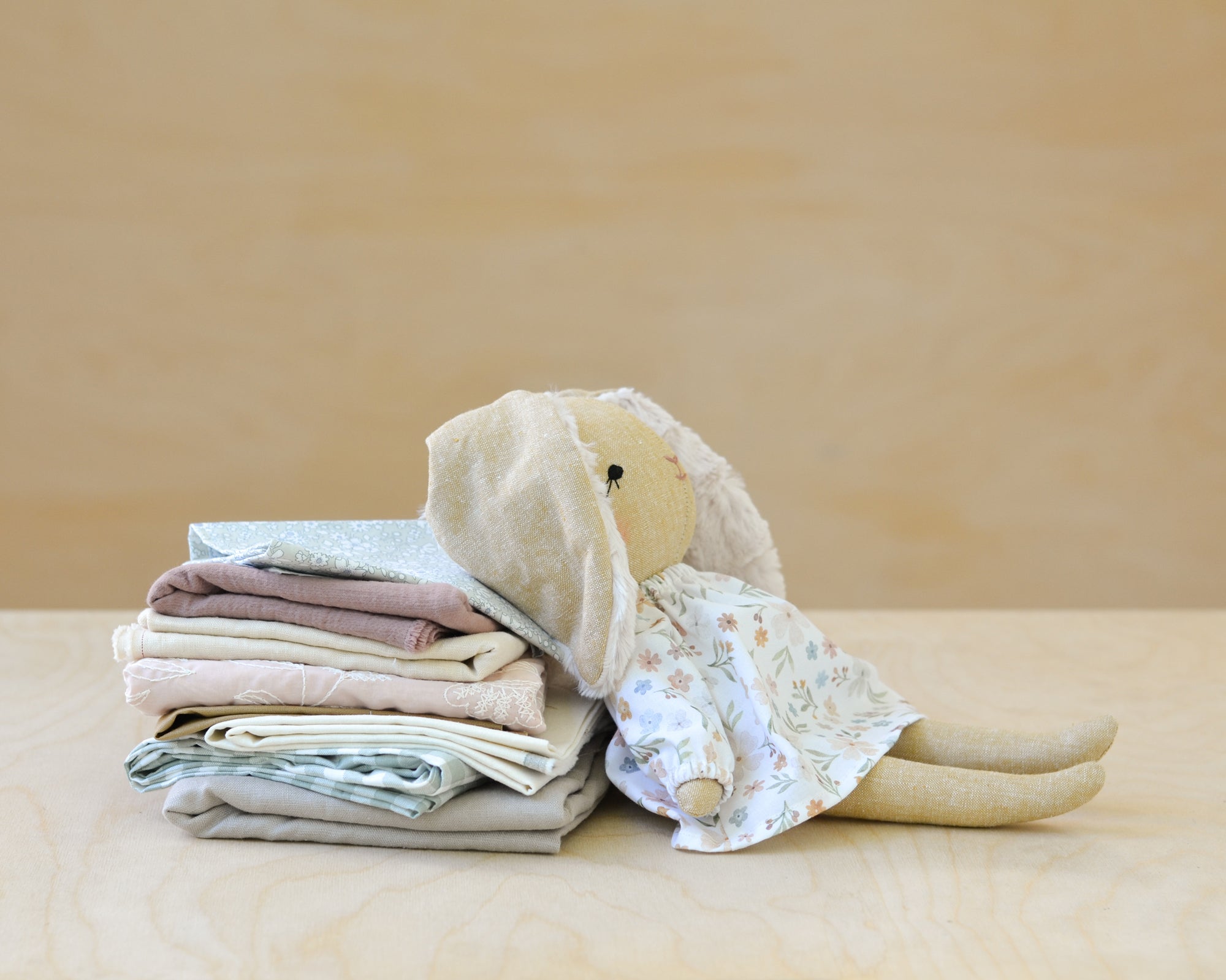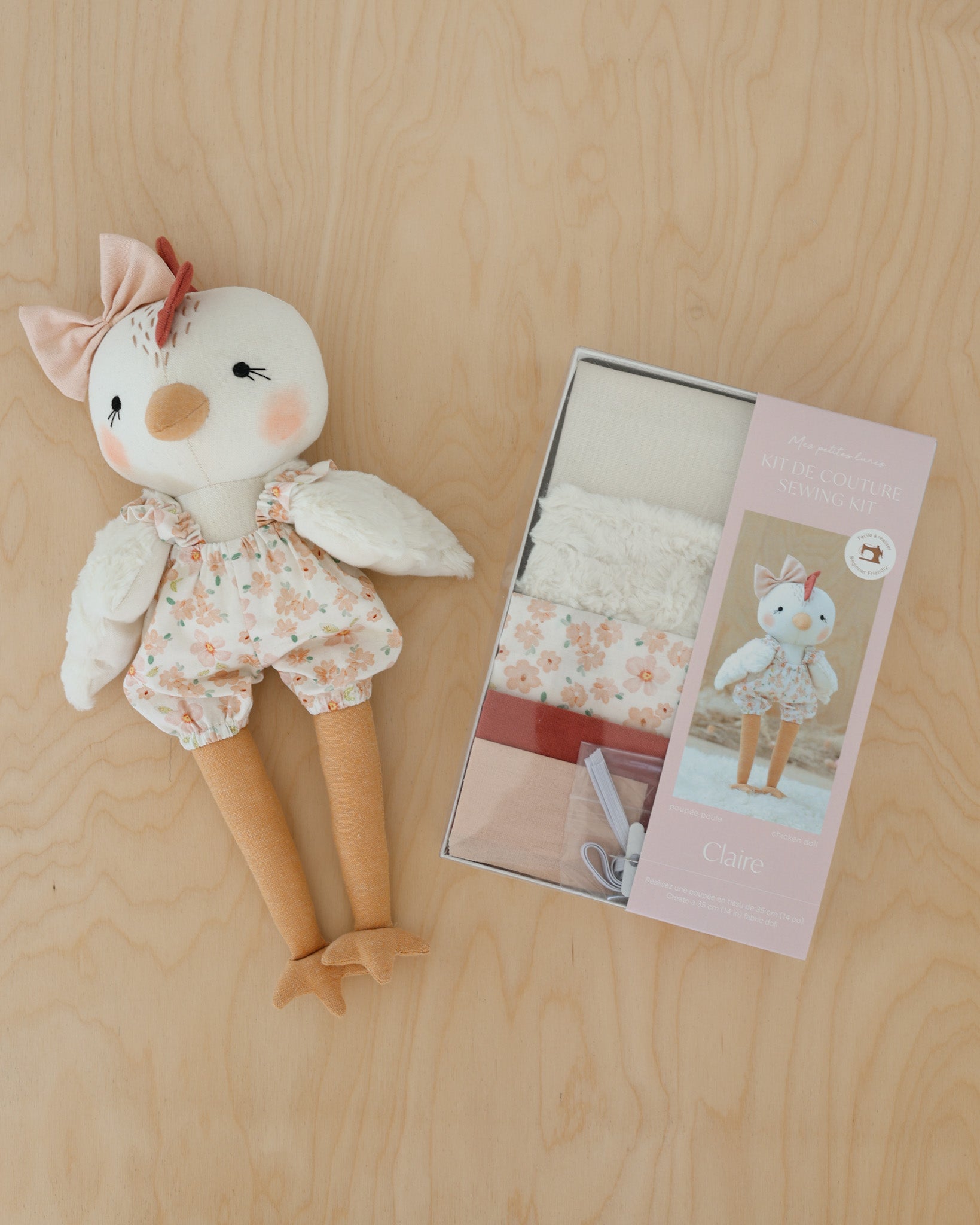Escolher o tecido certo é essencial na confecção de bonecas, pois afeta significativamente a aparência, a textura e a durabilidade do brinquedo de pelúcia. Neste artigo, discutirei os melhores tecidos para a confecção de bonecas e explicarei por que eles são ideais. Além disso, compartilharei meus tecidos favoritos e fornecerei alguns endereços onde você pode encontrá-los. Este artigo é o primeiro de uma série de oito, cobrindo tudo o que você precisa saber sobre a confecção de bonecas. Não se esqueça de se inscrever na minha newsletter para não perder os próximos artigos.
Primeiro, vamos apresentar alguns tecidos comuns usados na confecção de bonecas.
Algodão
O algodão é a fibra natural mais amplamente produzida no planeta, valorizada por sua maciez, facilidade de costura, lavabilidade à máquina e ampla disponibilidade. Sua versatilidade permite que seja tecido ou malhado, proporcionando inúmeras possibilidades para a confecção de roupas e têxteis. Existem vários tipos de algodão, como popeline, musselina, veludo cotelê, flanela, sarja e muitos outros, com pesos de tecido variando de leve a pesado.
Linho
O linho é um tecido natural feito de fibras vegetais, renomado por sua durabilidade e sustentabilidade. Ele amacia e desbota lindamente com o tempo, tornando-se uma escolha popular para roupas e utensílios domésticos.
As características do linho são facilmente reconhecíveis devido à sua textura crocante e aparência única. Ele tende a amassar, o que acrescenta ao seu visual distinto. Embora possa parecer resistente por causa de suas fibras grossas, ele se alisa e amacia a cada uso.
O peso do tecido de linho varia, indo de leve (90-130 gsm), a médio (140-190 gsm), até pesado (200-300 gsm).
Mistura de ambos
O tecido misto de linho refere-se ao linho que foi misturado com uma certa porcentagem de algodão. O teor de algodão em uma mistura de linho pode variar amplamente, de apenas 5% a até 70%, dependendo do uso pretendido do tecido.
Sentido
O feltro é um tecido não tecido feito de fibras comprimidas. É macio, resistente e fácil de trabalhar, ideal para criar acessórios de bonecas e pequenos detalhes. Não desfia, vem em várias cores e pode ser colado ou costurado.
Minky
Minky é um tipo de tecido feito de 100% fibras de poliéster. É peludo e luxuosamente macio, quase se assemelhando a pele de animal, embora seja completamente sintético. O tecido Minky é tipicamente peludo apenas de um lado e pode ser feito em diferentes espessuras. Ele lava muito bem e permanecerá macio mesmo após muitas lavagens. Existem diferentes tipos de Minky com diferentes comprimentos de pelagem.
Quais são meus tecidos favoritos para fazer bonecas?
Para corpos
Ao projetar e confeccionar minhas bonecas, confio em um tecido de alta qualidade, de peso médio, com um leve estiramento na diagonal e uma trama apertada. Esse tipo de tecido me permite criar cabeças bem arredondadas quando firmemente recheadas. Evito tecidos que sejam muito leves ou pesados; tecidos finos podem não ser duráveis e podem não ser fortes o suficiente para suportar o recheio, enquanto tecidos mais grossos podem dificultar a virada de partes pequenas, como pernas e braços. Uma trama apertada também é essencial para os corpos das bonecas, pois tecidos com uma trama solta desfiem facilmente e têm mais probabilidade de rasgar quando recheados. Para meus moldes, recomendo evitar malha, jersey, fleece ou quaisquer materiais elásticos, pois eles não manterão a forma da boneca adequadamente e as roupas podem não servir bem.

Embora eu ocasionalmente use 100% algodão, prefiro misturas de algodão e linho para o corpo das minhas bonecas. Essas misturas são mais flexíveis, menos propensas a amassar e têm algumas das características desejáveis do linho, enquanto são mais acessíveis do que o linho puro. Elas realmente combinam as melhores qualidades de ambos os tecidos. O linho puro, por outro lado, tende a ser muito fluido para corpos de bonecas, resultando em características menos definidas. Mas, se optar pelo linho puro, procure uma variedade de peso médio e tecido apertado.
Um dos meus tecidos favoritos para trabalhar é
linho Essex da Robert Kaufman, uma mistura de 45% algodão e 55% linho pesando cerca de 190 g/m2. Está facilmente disponível em uma ampla gama de cores. Tem uma trama apertada e uniforme, que é durável e fácil de trabalhar. É resistente sem ser muito grosso para obter um acabamento limpo.
No Canadá, você pode encontrar uma ampla variedade de linho Essex na linda loja
Elegante Virgule. Eles fazem envios para todo o mundo e oferecem frete grátis dentro do Canadá e dos Estados Unidos. A proprietária é incrivelmente doce e tem um excelente olho para algodão estampado, tornando também um ótimo lugar para encontrar tecidos bonitos para vestir sua boneca.
Para roupas
Para roupas de boneca, prefiro usar tecidos tecidos como algodão e linho. Tecidos leves funcionam bem aqui, pois não requerem enchimento. Aprecio o algodão 100% pelas inúmeras opções de estampas e pela facilidade de costura, enquanto o linho 100% oferece fluidez e uma textura única. Para itens como suéteres ou toucas, recorro a tecidos tricotados como sherpa, fleece ou jersey, mas tenha em mente que tecidos elásticos são mais difíceis de costurar e requerem agulhas especiais.

Eu também adoro usar linho. Sua textura e fluidez criam um visual deslumbrante para qualquer roupa de boneca. Para laços de cabelo, golas e mangas bufantes, prefiro linho leve, enquanto para vestidos, macacões e calças, opto por linho de peso médio. O tecido fica muito mais macio após a primeira lavagem, então lembre-se de lavá-lo antes!
Recentemente me apaixonei pelo linho Yorkshire. Sua textura é linda, e seu peso e trama apertada tornam muito fácil de costurar. Eu particularmente amo as cores blush e banana, que têm uma vibe de sorvete perfeita para o verão. Eu pedi esses na Fabric Wholesale Direct. Eles oferecem uma variedade de cores de linho brilhantes e neutras. A qualidade é excelente, e você também pode encontrar feltro, pelúcia sintética e muitos outros tipos de tecido lá.
Para acessórios:
Quando se trata de manchas de cor ou acessórios, eu opto por feltro de lã. Seu apelo estético e a natureza que não desfia o tornam ideal. O feltro de lã está amplamente disponível e vem em uma vasta gama de cores. Você pode encontrá-lo facilmente no Etsy.
Para orelhas texturizadas:
Para as orelhas, especialmente para animais como coelhos ou cães, prefiro usar Minky super macio para alcançar uma aparência aconchegante. Ao selecionar o Minky, priorizo variedades de alta qualidade com uma aparência luxuosa e de pelo longo. Pode ser desafiador encontrar esse tipo, já que muitas lojas tendem a oferecer Minky bolha em vez de Minky de pelo longo. Sua melhor chance geralmente é no Etsy, onde pode ser listado sob nomes como Minky de pelo longo, caribu ou Minky super macio.
Lembre-se de levar em conta o propósito da sua criação e os cuidados que ela exigirá ao longo do tempo. Com uma abordagem cuidadosa na seleção de tecidos, você estará no caminho certo para criar peças bonitas e duradouras que refletem seu artesanato e criatividade.Para receber atualizações, acessar ofertas exclusivas e maisInscreva-se em nosso boletim informativo
Obrigado
Ariane
xx










3 Comentários
Buenas tardes. Acabo de comprar dos patrones y me es imposible descargarlos. Gracias.
Silvia Jiménez
Bonjour, je suis en France je recherche le tissu de vos jolis doudou peut-on avoir plus de description sur la qualité du tissu utilisé pour la réalisation. Merci de la réponse par avance.
Claudine cottte
Thank you for all of these advices. I love Elegante Virgule and I spend too much money when I visit their incredible boutique…
Lucie Bernard
Deixe um comentário
Este site é protegido por hCaptcha e a Política de privacidade e os Termos de serviço do hCaptcha se aplicam.